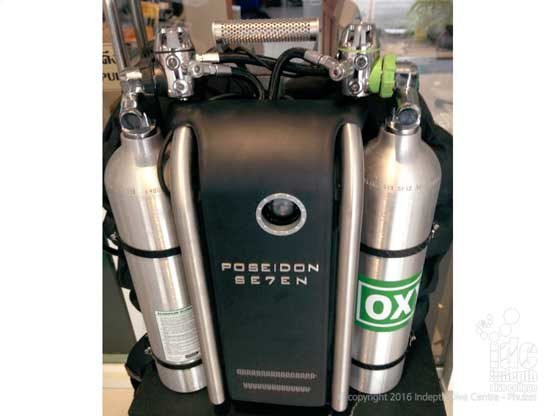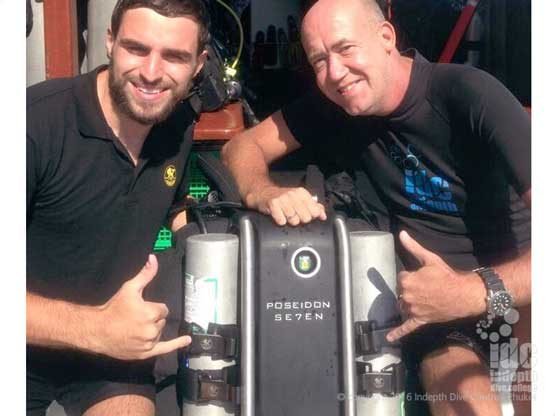
PADI Rebreather Courses and Tec Diving
PADI released the first PADI Rebreather Courses in 1999. This wasin response to PADI Member asking for Rebreather Courses to teach in order to meet growing market needs.
The first two Rebreather Courses to be released were the PADI Semi-Closed Rebreather Specialty Diver Courses. These were for the Dolphin / Atlantis and Draeger Ray Semi-Closed Rebreathers. The Dolphin / Atlantis and Draeger Ray Semi-Closed Rebreathers are very simple by today's standards and are “mechanical” units with no electronics. As such we call these SCCR units, as opposed to modern Electronic Semi-Closed Rebreathers, eSCR, we have today. In fact the Draeger Rebreather Courses are still available at the Diver levels and Rebreather Instructor levels.
What is a semi-closed Circuit Rebreather?
With a open circuit regulator you inhale from the tank and exhale all the gas. This goes out into the water as bubbles. With Semi-closed Circuit Rebreather diving, some of the gas you exhale will go into the sea. But some of the gas is is recycled and breathed again. Then every few minutes, the pressure will build up, and bubbles are released. This is a lot less than when diving on open-circuit but still a lot more than CCR. SCRs only use 1 gas supply to breathe from which is Nitrox. Remember when diving on Nitrox the gas mixture must be breathable at the deepest depth of the dive.
PADI SCCR courses are “Recreational.” This means dive planning using the Dolphin / Atlantis and Draeger Ray Semi-Closed Rebreathers No-Decompression limits with the Max Depth being 40m. For dive planning we use either formulas or the PADI EAD, EANx 32 / 36 Tables and PADI O2 Toxicity table.
PADI releases PADI Tec Rec Courses
In 2001 PADI / DSAT released the Open Circuit Tec Deep and EANx / He Gas Blender Courses. PADI TecRec programs take divers beyond the usual limits of recreational diving. The purpose of The Deep Tec Course was to bridge the gap between 40m and 50m. And in 2003 PADI released the Trimix Course.
Furthermore in 2009 the PADI TecRec Courses were renamed and restructured. This saw the release of PADI Tec 40, Tec 45 and Tec 50. The full PADI Tec Trimix Courses were also released. These consist of PAD Tec Trimix 65 and PADI Tec Trimix often called Tec Trimix 90. This qualifies divers to use any Trimix with 18% oxygen or higher. The maximum depth is 65 m/213 ft using multiple stage cylinders.The changes were to be able to offer more flexibility / options for divers wanting to progress in smaller steps. It also provided more options for becoming and advancing as a Tec Diver.
Finally in 2011 the PADI Rebreather Courses & PADI Tec CCR Rebreather Courses were released:
- PADI Rebreather Diver
- PADI Advanced Rebreather Diver
- DSAT / PADI Tec 40 CCR
- PADI Tec 60 CCR
- Tec 100 CCR
PADI is primarily a Recreational Diving Agency but does have Rebreather Courses. Consequently, with the release of courses using new technology which was once deemed “Tec” and "complicated." PADI felt the need to split Rebreathers into 2 categories for it new Rebreather Courses. Consequently rebreathers used for Rebreather Courses fall into 1 or 2 categories:
- Type R – Recreational Rebreathers
- Type T – Technical Rebreathers
Rebreather Courses: PADI Type R and Type T Rebreathers
What is a PADI Type R Rebreather?
To qualify for use during a PADI Rebreather Course it would need to be a Type R Rebreather. A Type R rebreather is an eCCR, such as the Poseidon MKVI or Se7en Rebreathers, or eSCR specifically suited to recreational, no decompression diving. There are various requirements for a Rebreather to classed as a Type R Rebreather to teach Rebreather Courses. These include the use pre-packed scrubber canisters and having a system for estimating scrubber duration. The Rebreather must also provide electronic prompts for the predive check. Additionally, Type R Rebreathers must provide automatic setpoint control and have status warnings to indicate problems. And the rebreather also needs a HUD (heads up display) warning system and a BOV or Bail Out Valve. This is what is needed for Recreational Rebreather Courses.
What is a PADI Type T Rebreather?
To qualify for use during a Technical Diving Rebreather Course, it would need to be a Type T Rebreather. A Type T Rebreather is an eCCR or mCCR suited to Technical Deep Diving, Decompression Diving and Cave Diving. Type T units have differing technical requirements and divers using them need more training and experience in using them. As such Type T characteristics include at least one backup display for use during manual oxygen control. Additionally, they must have manual controls for the diluent and oxygen supply, and may have user-packed scrubbers. The unit must be rated and functional to 100m. This is what is required for Technical PADI Rebreather Courses.
Is my Rebreather a Type R or a Type T Rebreather?
PADI maintains a register of Rebreathers that can be used for PADI Courses. This is a list of units that manufacturers specify meet the key features of a PADI Type R (Recreational) or Type T (Technical) Rebreather. Furthermore, they must also have successfully undergone recognized third-party testing against an appropriate standard such as EN14143.
Moreover: only rebreathers included in this register can be used for Rebreather courses.
Note: The PADI organization does not approve, review or endorse the design or manufacturing of scuba equipment, including rebreathers. If a Rebreather manufacturer wishes the unit to be taught on PADI Courses. Then it would need to meet the above criteria in order to even be considered for PADI Rebreather Courses.
To find out more please contact us about Rebreathers …







